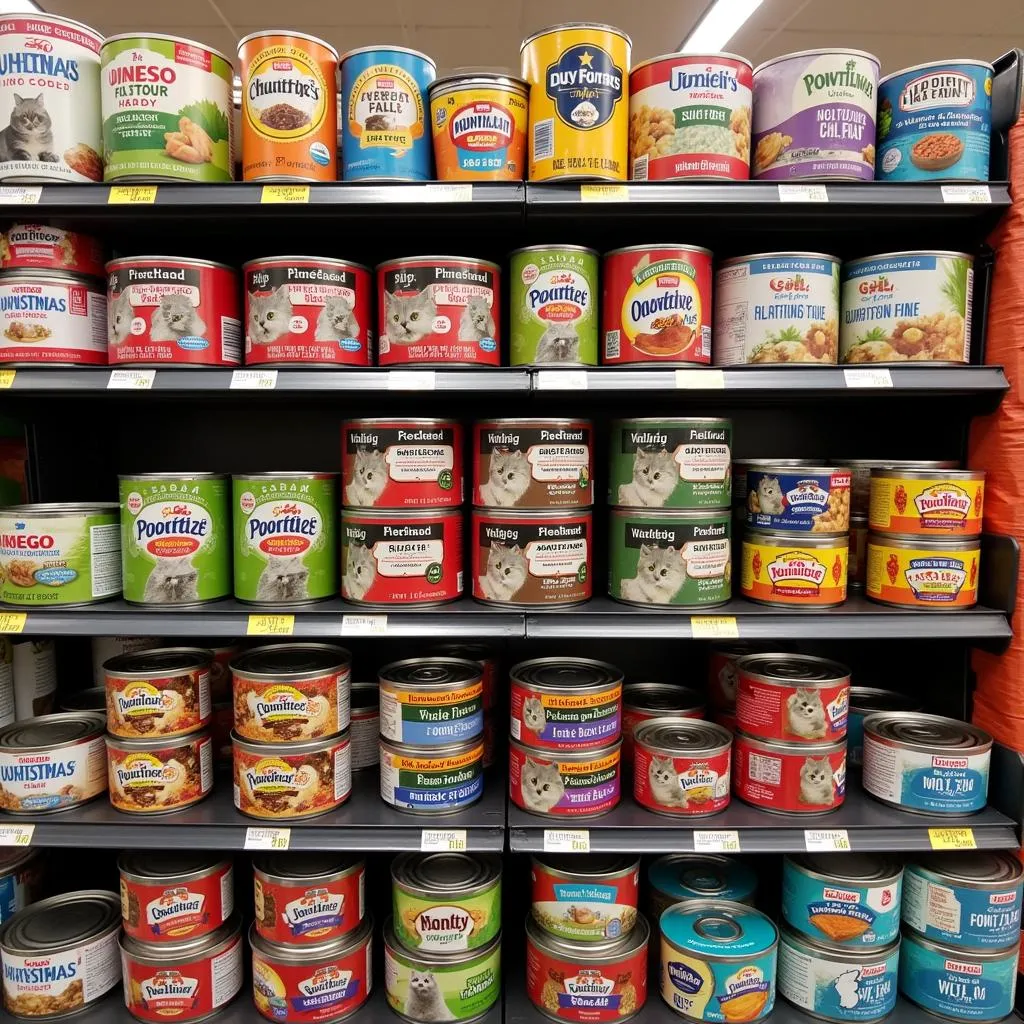Choosing the right food for your feline friend is a big responsibility. You want to make sure they’re getting the nutrition they need to thrive, and for many cat parents, that means seeking out high-quality canned cat food made in the USA. But with so many options available, it can be tough to know where to start. This comprehensive guide will help you navigate the world of American-made canned cat food, empowering you to make informed decisions for your furry companion.
 Cat food cans on a supermarket shelf
Cat food cans on a supermarket shelf
Why Choose Canned Cat Food Made in the USA?
For many cat owners, opting for US-made cat food, particularly canned varieties, offers peace of mind and several potential benefits:
- Stringent Safety Standards: The United States boasts strict regulations for pet food production, including ingredient sourcing and manufacturing practices. This focus on safety and quality control can provide reassurance for pet parents concerned about potential contaminants or questionable ingredients.
- Supporting American Businesses: Choosing US-made products often means supporting American jobs and businesses within the pet food industry.
- Shorter Supply Chains: Opting for locally-sourced ingredients and US-based manufacturing can potentially lead to shorter supply chains, reducing the environmental impact associated with transportation.
Decoding the Label: What to Look for in Canned Cat Food
Understanding cat food labels can feel like deciphering a foreign language! Here’s a breakdown of key elements to help you choose the best canned cat food for your furry friend:
1. Life-Stage Considerations: Kitten, Adult, or Senior?
Just like humans, cats have different nutritional needs at various life stages.
- Kittens: Growing kittens require food that’s higher in calories, protein, and essential nutrients like DHA to support their rapid development.
- Adult Cats: Adult cat food formulas are designed to maintain a healthy weight and provide balanced nutrition for everyday activity.
- Senior Cats: As cats age, their metabolisms may slow down. Senior cat food formulas often contain controlled calorie levels and may include added nutrients to support joint health and cognitive function.
2. Ingredient Quality: Meat First!
Cats are obligate carnivores, meaning their bodies are designed to thrive on a meat-based diet. When evaluating cat food made in the USA, prioritize these ingredient factors:
- Named Meat Source: Look for a named meat source (e.g., chicken, salmon, turkey) as the first ingredient. Avoid vague terms like “meat by-products” or “poultry meal,” as these can indicate lower-quality ingredients.
- Limited Ingredients: Some cats have sensitivities or allergies. Limited ingredient diets contain fewer ingredients, making it easier to identify and avoid potential triggers.
- Grain-Free Options: While not essential for all cats, grain-free formulas can be beneficial for those with grain sensitivities or allergies.
3. Moisture Content: The Importance of Hydration
One of the major advantages of canned cat food is its high moisture content. Cats have a naturally low thirst drive, and a diet rich in wet food can help keep them adequately hydrated and potentially reduce the risk of urinary tract issues.
Addressing Common Concerns About Canned Cat Food
Let’s address some common concerns cat owners have about canned cat food made in the USA:
Q: Is canned cat food more expensive than dry food?
A: Generally, yes. Canned food often uses higher-quality ingredients and has a more intensive production process, which can contribute to a higher price tag. However, the potential health benefits and increased hydration can make it a worthwhile investment for many cat owners.
Q: My cat is a picky eater. Will they eat canned food?
A: Canned food is often more palatable to cats due to its stronger aroma and texture. If your cat is hesitant to try canned food, gradual transitions and experimenting with different flavors can help.
Tips for Transitioning Your Cat to New Food
- Gradual Introduction: Suddenly switching your cat’s food can lead to digestive upset. Start by mixing a small amount of the new food with their current food, gradually increasing the ratio over 7-10 days.
- Monitor for Reactions: Keep a close eye on your cat’s litter box habits and overall health during the transition.
- Consult Your Veterinarian: If you have concerns about your cat’s diet or any underlying health conditions, it’s always best to consult with your veterinarian. They can recommend the best food options for your cat’s individual needs.
Beyond the Bowl: Enrichment and Mealtime Fun
Mealtime shouldn’t be boring! Here are some ideas to make your cat’s dining experience more engaging:
- Puzzle Feeders: Puzzle feeders encourage your cat to work for their food, providing mental stimulation and preventing boredom.
- Food-Dispensing Toys: These interactive toys dispense food as your cat plays, satisfying their hunting instincts.
- Food camp: Consider joining a food camp designed for cats to provide them with opportunities to socialize and explore new flavors and textures.
Conclusion: Nourishing Your Feline Friend with Confidence
Selecting the right canned cat food made in the USA is an important decision that directly impacts your cat’s health and well-being. By understanding label information, prioritizing quality ingredients, and considering your cat’s individual needs, you can make informed choices that support their long and happy life. Remember, your veterinarian is your best resource for personalized dietary advice.